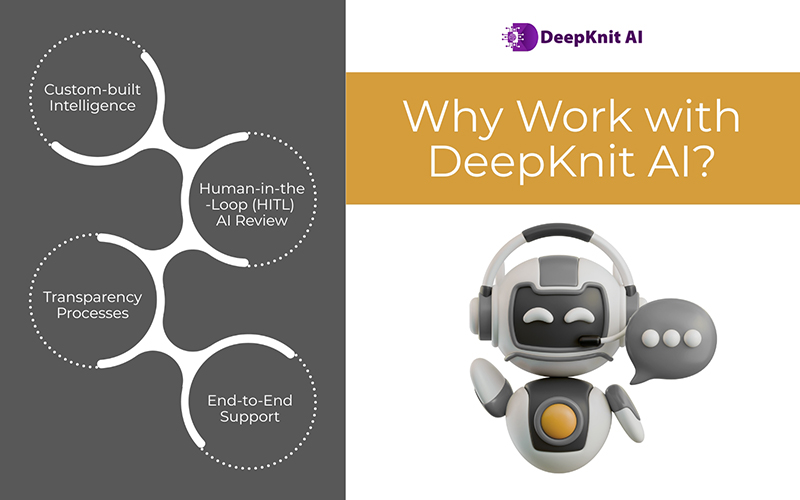In 2011, something remarkable unfolded on the popular quiz show, “Jeopardy!”
Watson—IBM’s supercomputer, defeated two of Jeopardy’s greatest champions to not just win the US$1 million, but also wow the tech industry and a corner of U.S. pop culture, by showcasing its remarkable ability to process natural conversation and understand complex questions.
In an era where Artificial Intelligence was considered a distant technology, Watson Health was hailed as a revolutionary force in AI as it entered the healthcare industry with a lot of aspirations, intent and fanfare.
However, those ambitions were short-lived. Why? Because in reality, life—and business—rarely fits neatly into one box. Especially not an “out-of-the-box” AI. In complex industries like healthcare or law, the need for custom AI solutions becomes evident quickly.
In a world that’s rapidly obsessing towards plug-and-play solutions for increased convenience, it’s tempting to believe that off-the-shelf AI tools can just about handle everything that’s thrown to them. It’s like drop them in, flip a switch and boom; it’s done. But here’s the truth: AI is powerful, yes, but it’s not magical. An out-of-the-box AI isn’t enough in solving complex, nuanced, or domain-specific problems.
So, let us explore everything in detail and when it’s time to bring in the big guns.
Understanding “Out-of-the-Box” AI
Out-of-the-box AI solutions can be likened to instant noodles: fast, easy and affordable and a good option for quick fixes. They can be utilized for basic automation, analytics dashboards, customer support bots, email filters, or text summarization.
They often are pre-trained on large datasets, with built-in models for tasks like speech recognition, translation, image classification, sentiment analysis, and more.
For startups and small businesses, these tools provide an opportunity to dip a toe into the AI waters without drowning in subsequent development costs. They’re also marketed to feel empowering: “No code needed!” “Deploy in minutes!” “Smart solutions for everyone!”
And of course, they’re useful. Until they’re not.
Why Off-the-Shelf AI Tools Fail in Complex Scenarios
The moment you try to use these generic tools to take on complex, real-world challenges, things start to break down. Here’s why:
- Your Data Is Too Niche
Like mentioned before, off-the-shelf AI is trained on generic datasets which are often English-heavy, U.S.-centric, and not fine-tuned for your industry. If your business has specialized jargon, multilingual content, disorganized legacy records, or diligent compliance needs (healthcare and legal sectors), generic AI will struggle to make sense of it all.
Example: A legal firm trying to automate case brief generation using a general text summarization tool will find that the output lacks nuance, misses critical legal points, or even misinterprets legal terms. That’s not only just unhelpful, but risky as well.
- Lacks Contextual Awareness
AI models don’t understand the way us humans do. It is because they work based on patterns, and not true reasoning. Out-of-the-box solutions often fail when asked to consider situational context, cultural nuances, emotional intelligence, or evolving business goals.
Example: A customer service chatbot might reply perfectly to FAQs. But, what about when a frustrated customer expresses emotions? Or when a crisis occurs and customers are in need of empathetic, human-like support? This requires deeper understanding and most of the time, a real person.
- You Can’t Customize It Enough
Off-the-shelf tools are often cramped with room for additional AI customization. Yes, you can tweak settings or plug in some vendor APIs, but that’s it. You’ll literally be boxed in by the original model’s capabilities. And, if you need something tailored, say, a recommendation engine based on your users’ behavior, not Netflix’s—you’re out of luck.
Example: A streaming platform may want to recommend niche thriller films based on user sentiment and prior viewing moods. Generic models don’t have the ability to pick up on the emotional subtleties, or might keep recommending mainstream content just because it’s “popular.”
- It Can’t Handle Edge Cases
AI models are notorious for failing on edge cases: the weird, unpredictable, or rare scenarios that deviate from the training data. In healthcare, law, finance, or manufacturing, edge cases are everywhere. And in many cases, they’re the ones that matter most.
Example: A diagnostic AI trained on textbook symptoms might miss a rare combination of conditions in a patient from a different ethnicity which would be something a seasoned doctor would catch. That’s where AI plus human expertise is vital.
- Ethical and Regulatory Risks
Out-of-the-box AI can be a black box. It’s difficult to always know what data it was trained on, on what criteria it makes decisions, or whether it’s biased. For regulated industries, this is a minefield. If the tool can’t provide transparency or explainability, it might land you in legal trouble.
Example: An HR team using AI to screen resumes could unknowingly deploy a biased model that favors one demographic over others. Without the ability to audit and tweak the model, you’d literally be flying blind and inviting unnecessary lawsuits.
The Human Touch: Why Intervention Still Matters
The most successful AI systems globally are not fully autonomous, but they’re human-in-the-loop AI (HITL). That means AI does the heavy lifting, but humans supervise, guide, and refine the process. This hybrid model brings out the best of both worlds as:
- AI handles scale, speed, and pattern recognition.
- Humans bring judgment, ethics, and domain knowledge.
Together, they make AI not just functional, but more meaningful.
The Significance of Custom AI
If you’re working in a field where precision, nuance, contextual intelligence and judgement matter, then off-the-shelf tools won’t cut it. You need AI that’s purpose-built. Trained on your data. Tuned to your workflows. Aligned with your goals.
This is where DeepKnit AI comes in.
Why Work with DeepKnit AI?
- Custom-built Intelligence
We design AI solutions that learn from your data, not someone else’s. Whether it’s a clinical decision tool, a claims-processing bot, or a smart content engine, we build it around your needs.
- Transparency You Can Trust
Our AI models are no black boxes. They come with explainability built-in, so you can audit decisions, ensure compliance, and build ethical systems.
- Human-in-the-Loop (HITL) AI Review
We never forget the human touch of the equation, which is indispensable. Our systems are designed for collaboration, not replacement so your experts stay in control.
- End-to-End Support
From data strategy to deployment and beyond, we’re your AI co-pilots. Think of us as your engineering dream team, minus the overhead.
Final Remarks
Out-of-the-box AI is a great starting point for any business enterprise. However, when the stakes go through the roof and challenges faced are real, pre-packaged agents aren’t fit to take on them—you need a custom AI that can come clutch in crucial moments.
You will require partners who understand your vision, your data, and your industry. And most importantly, you need humans and machines working in tandem.
So, the next time you hear “just use this AI tool,” ask yourself: “Is that really enough?”
If the answer is no, DeepKnit AI is here to help you do more; with intelligence that truly fits.


